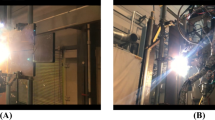Abstract
A new technology of double-sided arc welding (DSAW) in which gas metal arc welding (GMAW) is employed for root welding and filler passes was proposed in this paper. The realized master–slave mode, dual-robot collaboration provides the asymmetric and symmetric welding for root welding and filler passes, respectively, by two robots from both sides of the thick plate. Then, the multi-pass path planning was put forward, and Roboguide was used to verify the feasibility of the planning. Finally, welding experiment was conducted. The results indicate that the good comprehensive properties in tensile strength, bend property, impact toughness, and hardness were obtained. This new technology can realize no back chipping for thick plate welding. Furthermore, it has the potential advantages for the implementation of automatic welding for thick plate.
Similar content being viewed by others
References
Hashemi SH (2011) Strength-hardness statistical correlation in API X65 steel. Mater Sci Eng A 528(3):1648–1655
Gomez M, Valles P, Medina SF (2011) Evolution of microstructure and precipitation state during thermomechanical processing of a X80 microalloyed steel. Mater Sci Eng A 528(13):4761–4773
Rusinek A, Klepaczko JR (2009) Experiments on heat generated during plastic deformation and stored energy for TRIP steels. Mater Des 30(1):1748–1761
Show BK, Veerababu R, Balamuralikrishnan R, Malakondaiah G (2010) Effect of vanadium and titanium modification on the microstructure and mechanical properties of a microalloyed HSLA steel. Mater Sci Eng A 527(6):1595–1604
Kang YH, Na SJ (2003) Characteristics of welding and arc signal in narrow groove gas metal arc welding using electromagnetic arc oscillation. Weld J 82(5):93–99
Elmesalamy AS, Li L, Francis JA, Sezer HK (2013) Understanding the process parameter interactions in multiple-pass ultra-narrow-gap laser welding of thick-section stainless steels. Int J Adv Manuf Technol 68(1–4):1–17
Ding M, Tang XH, Lu FG, Yao S (2011) Welding of quenched and tempered steels with high-spin arc narrow gap MAG system. Int J Adv Manuf Technol 55(5–8):527–533
Liu LM, Wang JF, Song G (2004) Hybrid laser–TIG welding, laser beam welding and gas tungsten arc welding of AZ31B magnesium alloy. Mater Sci Eng A 381(1–2):129–133
Li CB, Liu LM (2013) Investigation on weldability of magnesium alloy thin sheet T-joints: arc welding, laser welding, and laser-arc hybrid welding. Int J Adv Manuf Technol 65(1–4):27–34
Hu B, Ouden GD (2005) Synergetic effects of hybrid laser/arc welding. Sci Technol Weld Join 10(4):427–431
Casalino G, Campanelli SL, Ludovico AD (2013) Laser-arc hybrid welding of wrought to selective laser molten stainless steel. Int J Adv Manuf Technol 68(1–4):209–216
Liu LM, Yuan ST, Li CB (2012) Effect of relative location of laser beam and TIG arc in different hybrid welding modes. Sci Technol Weld Join 17(6):441–446
Kutsuna M, Chen L (2002) Interaction of both plasma in CO2 laser-MAG hybrid welding of carbon steel. International Institute of Welding, IIW document, XII 1708: 341–346
Nielsen SE, Andersen MM, Kristensen JK, Jensen TA (2002) Hybrid welding of thick section C/Mn steel and aluminum. International Institute of Welding, IIW document, XII 1731: 1–15
Ghosal S, Chaki S (2010) Estimation and optimization of depth of penetration in hybrid CO2 laser-MIG welding using ANN-optimization hybrid model. Int J Adv Manuf Technol 47(9–12):1149–1157
Yan J, Gao M, Li G, Zhang C, Zeng XY, Jiang M (2013) Microstructure and mechanical properties of laser-MIG hybrid welding of 1420 Al-Li alloy. Int J Adv Manuf Technol 66(9–12):1467–1473
Rao ZH, Liao SM, Tsai HL (2011) Modelling of hybrid laser–GMA welding: review and challenges. Sci Technol Weld Join 16(4):300–305
Gao M, Mei SW, Wang ZM, Li XY, Zeng XY (2012) Process and joint characterizations of laser–MIG hybrid welding of AZ31 magnesium alloy. J Mater Process Technol 212(6):1338–1346
Zhang YM, Zhang SB (1998) Double-sided arc welding increases weld joint penetration. Weld J 77(6):57–62
Zhang YM, Pan C, Male AT (2000) Improved microstructure and properties of 6061 aluminum alloy weldments using a double-sided arc welding process. Metall Mater Trans A 31(10):2537–2543
Zhang YM, Pan C, Male AT (2001) Welding of austenitic stainless steel using double sided arc welding process. Mater Sci Technol 17(10):1280–1284
Zhang HJ, Zhang GJ, Cai CB, Gao HM, Wu L (2008) Fundamental studies on in-process controlling angular distortion in asymmetrical double-sided double arc welding. J Mater Process Technol 205(1):214–223
Zhang HJ, Zhang GJ, Wu L (2007) Effects of arc distance on angular distortion by asymmetrical double sided arc welding. Sci Technol Weld Join 12(6):564–571
Yang CD, Zhang HJ, Zhong JY, Chen YX, Chen SB (2014) The effect of DSAW on preheating temperature in welding thick plate of high-strength low-alloy steel. Int J Adv Manuf Technol 71(1–4):421–428
Isao M (1979) A program for setting CO2 horizontal fillet welding parameters with given leg lengths and welding speed. J Jpn Weld Soc 48(7):94–98
Author information
Authors and Affiliations
Corresponding author
Rights and permissions
About this article
Cite this article
Yang, C., Zhong, J., Chen, Y. et al. The realization of no back chipping for thick plate welding. Int J Adv Manuf Technol 74, 79–88 (2014). https://doi.org/10.1007/s00170-014-5927-z
Received:
Accepted:
Published:
Issue Date:
DOI: https://doi.org/10.1007/s00170-014-5927-z




